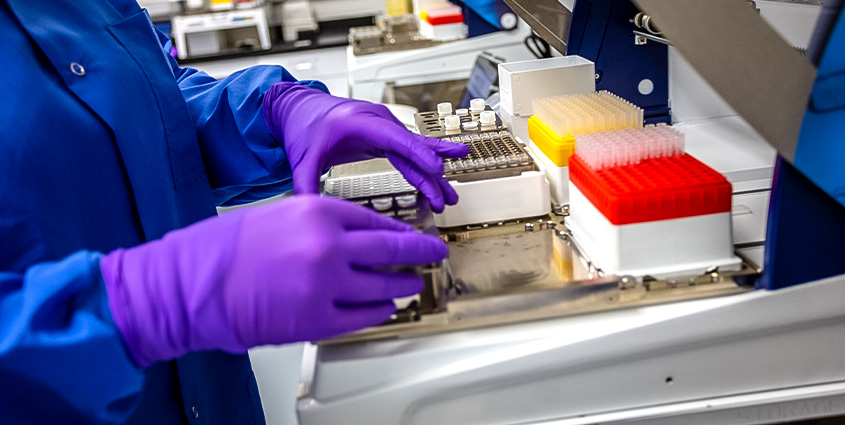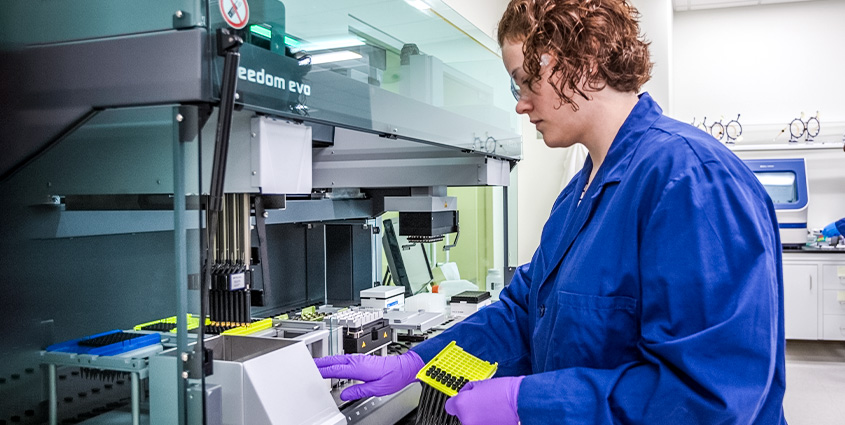Selecting Lab Automation Instruments
Selecting which automation instrument to purchase can be a daunting task, especially with the number of available options. You should start by defining clear goals for your automation project. After determining if an instrument meets your goals, you’ll also need to identify if the provider will be a partner you can rely on for service, maintenance, updates and initial programming.
Learn practical tips for choosing an automation partner, navigating instrument capabilities and optimizing protocols.
Getting Started with Picking an Automation Instrument
As you research and shop for instruments, it’s important that you consider:
- What do I need the instrument to do?
- What technical features will support my goals and priorities?
- Will the instrument supplier be a good partner?
- Can I retrofit an instrument I already have?
With these higher-level questions in mind, you’ll be able to have better conversations about technical performance and features and service quality.
Questions to Ask About Technical Features
What features are available with your budget?
There are automation instruments for nearly any budget. We’ve put together an open-source list of robotic instruments and their approximate price range. Costs ranges are estimated on base models and will vary depending on additional hardware and/or customization.

Do you need liquid handling?
Magnetic particle- (or bead) moving robots are sometimes preferred because they are easy to use, maintain and program and are often less expensive than liquid handling robots. However, particle movers are not as versatile and typically limited to applications like nucleic acid extraction, protein purification and cell isolation. For example, the ThermoFisher KingFisher System does not enable sample management and may require manual reagent dispensing and other manual manipulations. However, the ThermoFisher Presto System uses the same technology but can be integrated onto a liquid handler for fully automated sample processing.
Our Maxwell® RSC 48 uses magnetic particle mover technology with a ready-to-go cartridge-based format to process 1–48 samples per run. Simply load your samples and go. Learn more about this instrument.
What liquid volumes will you need to transfer?
Most 8-channel liquid handling systems can handle the following ranges of liquid transfer volumes.
- 1–10µl
- 10–200µl
- 50–1000µl
- 100–5000µl
Some 96-channel liquid handlers can transfer up to 1ml, though that depends on the provider. Discuss with the vendor which of their system is the best option for your needs.
Your pipetting accuracy and precision requirements can exclude some vendors from your search. Define the accuracy and precision required for your application to ensure you purchase an instrument matching your needs.
Your accuracy requirements may be affected by your lab’s environment. For example, miniaturizing a process like library preparation can be greatly affected by relative humidity. If you work in a dry climate, you may need a humidifier or non-conductive tips to reduce static and achieve accurate pipetting with a liquid handling robot. Other options are to discharge conductive tip boxes or to wipe down the boxes with a damp cloth before use.
What instrument deck space do you need?
As you plan for expanded capacity in the future, consider buying an instrument that has more space than what you currently require and that can incorporate an upgraded pipette size. Alternatively, you can buy an instrument that has enough space to accommodate your current needs and plan to purchase another instrument in the future.

What hardware do you need for your workflow?
Your workflow could require heating blocks, cooling blocks, thermocyclers, shakers or mixers, magnetic stands, robotic arms, barcode readers, tip hotels and more. Walk through your workflow with a vendor to learn if they can incorporate the hardware you’ll need.
What throughput do you need?
Your workflow’s throughput will depend on the number of pipette channels on your liquid handling robot. Typically, pipettes come as 8-, 96- or 384-channel units, and some providers and instrument sizes do not offer all channel formats. You will also need to get a sense of how many samples an instrument can process in a given amount of time with specific hardware and kit chemistries. Application notes from the kit provider or instrument vendor can help.
How much operational redundancy do you want?
Many labs purchase two smaller automated platforms rather than one larger platform to have redundancy and avoid delays in case one instrument is down for repairs or maintenance. These customized instruments cannot be readily replaced, so you’ll need to carefully consider if you can afford to not have a backup.
Can your facility accommodate an instrument’s requirements?
Facility requirements are often overlooked and may determine where your instrument can be installed. Air vent locations and air flow direction should be considered for cross contamination risks and safety. If your lab is not on the ground floor, additional floor supports may be required to accommodate larger systems that exceed a floor’s weight capacity. Your lab may need to install new electrical outlets if there are not enough in the optimal installation site. Many of these factors can be modified in collaboration with your facilities manager, but you may need to pay for the changes or explore instruments that will work with your space better. Your vendor can provide specific requirements.
What instruments and workflows have been used for similar applications?
Developing and implementing automated methods is not trivial. Find application notes and references for labs that have already implemented similar systems to your needs.
How customizable is the instrument for future upgrades?
Ask vendors what it would take to upgrade the throughput of an automated system in the future. For example, to switch between 8-channel and 96-channel pipettes, some robotic arms cannot be swapped out without overhauling the entire system. The costs of different robotic arm models may be very similar, but not all models can be easily upgraded in the field.
Custom solutions, or solutions that don’t exist or where there is no part number, are quite common for liquid handling instruments. If custom is offered as a solution, ask for examples of custom work done elsewhere. Consider carefully if custom solutions are right for you. Custom options can increase shipping time and costs for the initial purchase and for any replacement parts. Make sure to ask which components and features of the system you’re considering are “off the shelf” or custom. If custom parts are needed, price out your custom options from multiple vendors. Some vendors will sell “custom” solutions at a standard price, but others may charge more for customization.

What are the financial and environmental costs of consumables?
If you want to reuse pipette tips to reduce waste and costs, you’ll need the proper isolation tools for tip reuse. Reusing tips can save up to $40–50 per run, so the cost of those tools can be recouped.
Can a vendor guarantee a supply of required consumables?
If a vendor can’t guarantee a steady and sufficient supply of consumables or has long backlogs, ask if you can use alternative supplies without voiding the instrument’s warranty.
How to Assess Service Options
The company you choose to purchase your automation instrument from is more than a vendor. When you purchase a liquid handler, it is not trivial to switch to another vendor in the future. Methods do not directly transfer between platforms: methods would have to be rebuilt, reverified and revalidated; and maintaining a knowledge base of multiple platforms and programming languages is not ideal. Your automation instrument provider will be a long-term partner, so make sure that you can work well with their entire team.
- Meet with the company’s sales team
- Meet with the company’s applications team
- Ask for references and interview them
- Ask if there is a colleague at your institution using a similar instrument
Retrofitting an Existing Automation Platform
If you have an unused automation platform in your lab, you might be able to retrofit it to your needs. Use this guide to understand how the existing platform fits your needs and what new hardware you might need.
- Discuss workflow and existing instrument with vendors to discuss best ways to reach your goals
- Reach out to vendors for quotes
- Request demonstrations
- Request references
Or you can partner with our Field Support Scientists, who have decades of experience automating our kit chemistries on a wide range of platforms and throughput scales. We’ll help you customize the scale, application, and chemistry exactly to your needs, regardless of platform.
Automate Your Lab Worksheet
Plan your lab automation project with this worksheet.